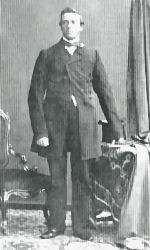Pieter Caland

Pieter Caland
Pieter Caland (Zierikzee, 23 July 1826 - Wageningen, 12 July 1902) was a Dutch civil engineer in the service of the Rijkswaterstaat. He devised the plan for the Nieuwe Waterweg and implemented it from 1866 to 1872.
This visionary project was not without problems and setbacks. Part of the canal had to be dug through wide dunes and special provisions were made for the siting of the channel counter, leading it to run over-time and over-budget and causing Caland to be criticised. However, the new canal caused a boom in trade into Rotterdam and thus fully justified its costs.
Namesakes
- A canal and a bridge near Rozenburg.
- In Rotterdam, near the Veerhaven, Calandstraat and the Calandmonument.
- In Zierikzee, the Calandweg and the Calandplein.
- In Amsterdam, the Calandlyceum in Osdorp and the Pieter Calandlaan in Osdorp.
- One of the metro lines in Rotterdam, the Caland Line, was named after him.
- In The Hague, the Calandkade, Calandstraat and the Calandplein.
- In Dordrecht, the Calandstraat and the industrial park Dordtse Kil II.
- In Breda, the De Calandstraat
- In Arnhem, the Pieter Calandweg and the industrial park De Kleefse Waard.
External links
| Wikimedia Commons has media related to Pieter Caland. |
|
This article is issued from Wikipedia - version of the Sunday, May 17, 2015. The text is available under the Creative Commons Attribution/Share Alike but additional terms may apply for the media files.